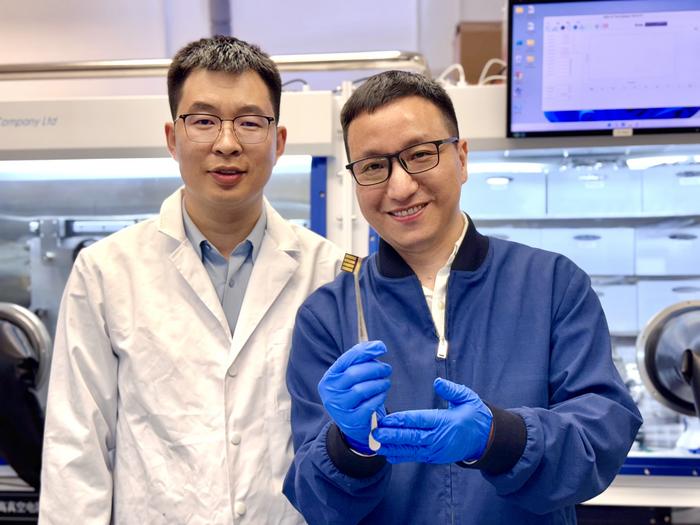
A groundbreaking achievement in the world of renewable energy has emerged from a collaborative research effort led by the Hong Kong University of Science and Technology (HKUST) in conjunction with the Hong Kong Polytechnic University (PolyU). This innovative endeavor focuses on the development of an advanced laminated interface microstructure that significantly bolsters the stability and photoelectric conversion efficiency of inverted perovskite solar cells. As the quest for sustainable energy solutions grows increasingly critical in today’s ecological landscape, this research reveals promising prospects for efficient solar energy harnessing.
Perovskite solar cells have garnered considerable attention in recent years, primarily due to their capacity to rival traditional silicon-based solar technology. Renowned for their high efficiency, affordability, and aesthetic advantages, perovskite cells possess the potential to revolutionize energy sources across diverse applications, spanning from grid electricity to portable devices and even space photovoltaics. The fundamental architecture of perovskite solar cells is generally categorized into two formats: standard and inverted. Significantly, the inverted structure has demonstrated greater viability for practical applications, attributed to its enhanced stability in the electronic materials employed across its layers.
Despite the potential benefits of inverted perovskite solar cells, challenges remain, particularly within the domain of interface science. The critical issue revolves around defect accumulation at the interface between the fullerene-based electron transport layer and the perovskite surface. These accumulated defects can profoundly impact device performance and longevity, underscoring the need for innovative solutions to address these vulnerabilities. As such, addressing interface stability is pivotal to unlocking the full potential of perovskite technology.
Leading this innovative research is Prof. ZHOU Yuanyuan, an Associate Professor in the Department of Chemical and Biological Engineering (CBE) and the Associate Director of the Energy Institute at HKUST. Prof. Zhou’s team has engaged in meticulous fundamental research on perovskite optoelectronic devices, emphasizing a unique structural perspective. In a strategic collaboration with Prof. CAI Songhua’s team from PolyU’s Department of Applied Physics, the researchers set out to explore new methodologies to mitigate interface defects and optimize energy level alignment through advanced structural designs.
The core breakthrough of this research is the formulation of a “three-ply” laminated structure, integrating a molecular passivation layer, fullerene derivative layer, and a two-dimensional (2D) perovskite layer. By uniformly applying this laminated microstructure to the surface of the perovskite film, the team successfully minimized defect density at the interface, which correlates directly with enhanced energy performance and improved efficiency metrics. This meticulous design propels the photoelectric conversion efficiency of the perovskite solar cell to new heights, thereby solidifying its application durability even under tough environmental conditions such as damp-heat and extended light exposure.
Co-first author Dr. GUO Pengfei, a postdoctoral fellow at HKUST’s CBE, remarked on the innovative nature of their findings, stating, “We introduced the concept of composite materials into the interface design of optoelectronic devices, allowing the synergistic effects of each layer in this new interface to achieve results that are unattainable with traditional interface engineering.” This assertion highlights the collaborative nature of the scientific endeavor, emphasizing how interdisciplinary approaches can yield transformative advancements.
Prof. Zhou elaborated on the unique attributes of perovskite materials, explaining, “Perovskite is a soft lattice material. We can create microstructural features in this type of material that are difficult to achieve with conventional materials.” His team’s ambition extends beyond mere efficiency enhancements; they aim to decipher the fundamental mechanisms underlying the formation of these microstructures at nanoscale, even down to the atomic level, in order to drive future innovations in perovskite devices.
The culmination of this intensive collaboration and innovative research has resulted in a published paper in the prestigious journal Nature Synthesis, under the title “Synthesis of a Lattice-Resolved Laminate-Structured Perovskite Heterointerface.” This publication not only showcases the researchers’ novel advancements but also positions their findings within the broader scientific discourse surrounding synthetic materials and optoelectronic technology.
Given the pressing need for effective renewable energy solutions, the implications of this research extend far beyond theoretical advancements, resonating with the global push towards sustainability and energy efficiency. The potential applications of enhanced perovskite solar cells could pave the way for a new generation of solar energy technologies that can adapt to diverse environments and operational demands.
As the research community continues to grapple with the challenges of solar energy conversion, the innovative strides made by HKUST and PolyU provide a beacon of hope. By addressing fundamental barriers in perovskite solar cell technology, this research holds the promise of unlocking a pathway toward higher efficiency and greater reliability in renewable energy systems.
Furthermore, this work serves as a compelling example of the power of collaborative research in tackling complex, multidisciplinary challenges. Such collaborations not only enhance the depth of inquiry but also inspire future generations of researchers to pursue knowledge that could one day transform the global energy landscape. The implications of improved perovskite solar cells extend beyond immediate energy solutions, hinting at the possibility of entirely new paradigms in sustainable energy technology.
The researchers’ work exemplifies how targeted, applied scientific innovation can lead to meaningful change. As these findings disseminate throughout the scientific and engineering communities, they could catalyze further research in the field, ultimately contributing to more effective energy solutions to address the ecological challenges facing the planet today.
Ultimately, this revolutionary approach to interface engineering within perovskite solar cells embodies the potential for continued innovation within the renewable energy sector, offering the hope of a brighter, more sustainable future.
Subject of Research: Development of laminated interface microstructure for perovskite solar cells
Article Title: Synthesis of a lattice-resolved laminate-structured perovskite heterointerface
News Publication Date: 29-Apr-2025
Web References: https://www.nature.com/articles/s44160-025-00787-7
References: http://dx.doi.org/10.1038/s44160-025-00787-7
Image Credits: HKUST
Keywords
Perovskite solar cells, renewable energy, interface engineering, stability, photoelectric conversion efficiency, HKUST, PolyU.
Tags: advanced solar cell architectureaffordable solar technologyecological energy advancementsHKUST PolyU collaborationinterface science challengesinverted perovskite technologylaminated interface microstructureperovskite solar cell innovationRenewable energy solutionssolar cell performance enhancementsolar energy efficiency improvementstability in solar cells





